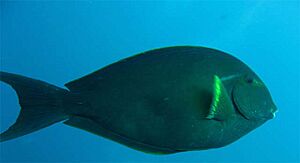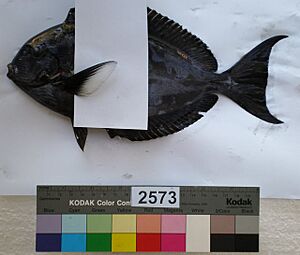Whitefin surgeonfish facts for kids
Quick facts for kids Whitefin surgeonfish |
|
|---|---|
 |
|
| Conservation status | |
| Scientific classification |
The whitefin surgeonfish, also known as Acanthurus albipectoralis, is a type of ocean fish. It's part of the family called Acanthuridae. This family includes surgeonfishes, unicornfishes, and tangs. You can find this special fish in the western part of the Pacific Ocean.
Contents
About the Whitefin Surgeonfish
The whitefin surgeonfish was first officially described in 1987. Two scientists, Gerald R. Allen and Anthony Michael Ayling, gave it its name. They found it near the Swain Reef in the Great Barrier Reef off Queensland, Australia.
What's in a Name?
The scientific name for this fish is Acanthurus albipectoralis. The second part of its name, albipectoralis, tells us something important. It comes from two Latin words: albus, which means "white", and pectoralis, which means "pectoral". This name refers to its white pectoral fins. These fins are white at the ends, which stands out against the fish's mostly black body.
What Does It Look Like?
The whitefin surgeonfish has a body that is shaped like an oval. It is also flat from side to side. Its snout, which is like its nose, is a bit blunt or rounded.
Its top fin, called the dorsal fin, and its bottom fin, called the anal fin, are quite long. They are also low on its body. The dorsal fin has 8 or 9 strong spines and 22 to 33 soft rays. The anal fin has 3 spines and 18 to 31 soft rays.
The tail fin, or caudal fin, looks like a crescent moon. It has pointed tips on each side. The whole fish is black, and it doesn't have any wavy blue lines. The base of its pectoral fins is blackish, but the outer part is clearly white. This fish can grow up to about 33 centimeters (about 13 inches) long.
Where It Lives and What It Eats
You can find the whitefin surgeonfish in the southwestern Pacific Ocean. They live in places from eastern Australia all the way to Tonga. These fish like to live on the outer edges of coral reefs. These areas are often exposed to the open ocean.
They usually swim in small groups. You can often see them high up in the water. They eat tiny animals called zooplankton. These are small creatures that float in the ocean.



